#context: babe ruth the baseball player
Explore tagged Tumblr posts
Text
“I’m made for this. call me babe”
#OKAY BABE 💗💗💗💗#context: babe ruth the baseball player#caitlin clark#wbb#women's basketball#iowa wbb#iowa hawkeyes#indiana fever
264 notes
·
View notes
Note
I'm not the previous anon, and I have no ill will toward you for your love of the Dodgers. I do however have ill will toward your love of a ball league that is actually somewhat successful, as a life long Pirates fan. MUST BE NICE TO GET RESULTS
*SIGH*
Thank you anon but love is a big word to use here. I could not name a single player on the dodgers or any baseball player in the world besides babe ruth, Jackie Robinson, and the one my mutual keeps writing RPF about (Bosch or something like that…). I only know they’re doing well right now due to context clues from my dash. I was however dragged a long to a few dodgers games when I was like 10 and think I owned a pink dodgers hat at some point so I guess that’s my team and Im glad they’re doing well 💜
5 notes
·
View notes
Note
18, 22, 24!
meme train toot toot
18. What's their favorite movie?
It's so hard to pinpoint one movie that Liberty loves the most, but I will make it happen! For context, she adores movies from the 1970s. Large IPs from that time includes Star Wars, the Godfather, Jaws, Grease, the Excorcist, M*A*S*H--the list goes on! Her favorite movie of all time, that she will always watch, is Carrie (1976). The themes of adolecense, the music score, the unapologetic horror, southern gothic, the third act--oh my goodness, she can go on and on about it! Liberty is a sucker for many things and women's scorn is one of them.
22. Do they have any hobbies
Liberty is a person of many hobbies. If she is interested in an activity, she will pick it up and learn about the subject until she is bored. There has been many instances of miniature figures painting, embroidery, alien hunting (cough), flying planes, and making bread. Currently, she is very interested in fixing old cars. She has a fascination in mechanics and loves fixing broken things. Lately, she's been on gaming with the urge to stream. However, she has such a rage that she was advised not too by a few friends. For now, she's stuck in her garage restoring a 1967 Chevy Camaro.
24. Which person (dead or alive) would they most want to meet?
She really wants to meet Shohei Ohtani. He's alive and is a well-known baseball player of the Los Angeles Angels. The reason why she really wants to meet him is that Shohei, is very likely, the most best baseball player to live in this century. He is on par (or even above) that of famous players like Babe Ruth. Liberty genuinely believes this person is non-human by how amazing he is in baseball. If she can just shake his hand, her life would be completed. She's a simple person, she did not think that deep of who she would really meet. Liberty really likes baseball, sorry.
2 notes
·
View notes
Text
Understanding the Value of Vintage Sports Gear in Auctions

Vintage sports gear holds a special place in the hearts of collectors, athletes, and enthusiasts alike. From old-school baseball gloves to retro tennis rackets and jerseys, these items not only have historical value but can also be valuable investments. When shopping at sports memorabilia auctions, understanding the value of vintage sports gear is crucial to making informed purchasing decisions. Several factors contribute to the value of these items, and recognizing them can help you score a great deal or find a prized collectible.
Historical Significance
The historical context of an item plays a major role in determining its value. Vintage sports gear that is tied to a significant moment in sports history, such as an iconic game, famous athlete, or championship event, can command higher prices at auction. For example, a pair of boxing gloves worn by Muhammad Ali or a baseball bat used by Babe Ruth would be highly sought after by collectors due to their direct connection to historic events. Understanding the history behind an item and its connection to memorable moments can give you insight into its potential worth.
Rarity and Scarcity
Rarity is a major factor in determining the value of vintage sports gear. Items that were produced in limited quantities or are no longer available tend to be worth more. For instance, early editions of sports equipment, such as the first models of a famous brand’s cleats or a limited-edition autographed jersey, are considered rare and highly collectible. The more difficult it is to find a specific piece of gear, the more valuable it becomes. Researching the production history of the item and understanding how many were made or still exist can help you gauge its rarity and determine its potential market value.
Condition and Quality
The condition of vintage sports gear is one of the most significant factors that impact its value. Items that have been well-preserved and are in excellent condition typically command higher prices than those that are worn or damaged. This is particularly true for gear such as baseball gloves, tennis rackets, and other equipment made of leather or wood, which can deteriorate over time. When evaluating vintage sports gear at auctions, always inspect the condition carefully. Look for any signs of wear, discoloration, or repairs that may affect its functionality or aesthetics. The better the condition, the higher the value, but even items in less-than-perfect condition may still hold value depending on their rarity and historical significance.
Brand and Athlete Associations
The brand and the athlete associated with the gear can also significantly influence its value. Items used or endorsed by legendary athletes, such as autographed memorabilia or gear worn by Hall of Fame players, tend to fetch higher prices. For instance, a vintage pair of Converse basketball shoes worn by Michael Jordan during his early years could be worth far more than a similar pair without such a connection. Similarly, iconic brands like Wilson, Spalding, and Rawlings often see their vintage equipment increase in value due to their established reputation in the sports world.
Market Demand and Popularity
The current demand and popularity for vintage sports gear can fluctuate over time. Trends in sports memorabilia and nostalgia for certain eras or athletes can affect how much people are willing to pay for vintage gear. For example, interest in 1990s basketball memorabilia surged after the release of documentaries like "The Last Dance," which focused on Michael Jordan’s career. Tracking trends in the market and understanding the cultural relevance of specific sports items can help you anticipate their value at auction. Timing your purchase or sale can make a significant difference in how much you can expect to pay or receive.
Provenance and Authentication
Provenance, or the documented history of ownership, and authentication are essential factors when it comes to vintage sports gear. Items with verified origins or a well-documented chain of ownership, particularly if they were previously owned by famous athletes or used in high-profile events, are often more valuable. Many vintage sports gear items, especially signed memorabilia, require certificates of authenticity (COAs) or professional grading to assure potential buyers of their legitimacy. Ensuring that the item you are interested in has proper documentation can help safeguard against purchasing a counterfeit or misrepresented piece.
Conclusion
Understanding the value of vintage sports gear in auctions requires knowledge of historical significance, rarity, condition, and brand associations. With the right research, you can confidently assess whether an item is worth bidding on or if it holds significant investment potential. Whether you're a collector looking for rare finds or a sports fan hoping to own a piece of history, recognizing the factors that influence the value of vintage sports gear can help you make smarter, more informed auction decisions.
0 notes
Text
Exploring MLB Pickle: An Insight into Baseball's Quirky Term
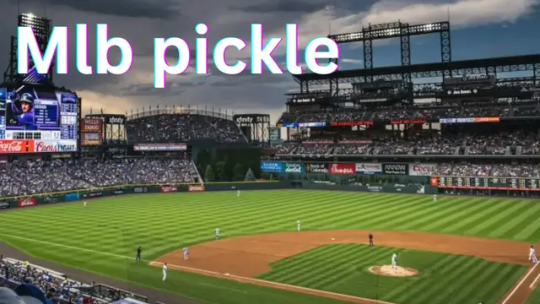
When you think of baseball, certain terms might come to mind: home run, strikeout, double play. But have you ever heard of a "MLB pickle"? It's one of those quirky terms in baseball that might leave you scratching your head if you're not familiar with the game's vernacular.
The term "pickle" in baseball refers to a situation where a baserunner is caught in a rundown between two bases, typically between third and home or second and third. It's a high-pressure scenario where the baserunner must evade being tagged out by the opposing team's fielders while trying to make it safely to the next base.
So why is it called a "pickle"? The origin of the term is somewhat murky, but it's believed to have roots in 19th-century America, possibly deriving from the term "pickle barrel" which referred to a tight spot or difficult situation. Over time, this evolved into the baseball context we know today.
In a MLB pickle, the baserunner must use quick thinking, agility, and sometimes sheer luck to outsmart the opposing team and make it safely to the next base. It's a thrilling moment in the game that can swing momentum in favor of either team.
However, executing a successful pickle requires more than just athleticism. It also involves strategic communication and coordination among the fielders to effectively trap the baserunner and prevent them from advancing. A well-executed pickle can result in an exhilarating out for the defensive team, while a blunder can lead to an extra base for the offensive team.
Despite its potential for excitement, the MLB pickle is often seen as a risky play. If not executed properly, it can backfire and allow the baserunner to advance or even score a run. As such, teams must weigh the potential rewards against the inherent risks when deciding whether to engage in a pickle situation.
In recent years, the MLB pickle has become a topic of fascination among baseball fans, who relish the opportunity to witness the strategic maneuvers and athletic prowess on display during these tense moments. It's yet another example of the rich tapestry of terminology and traditions that make baseball such a beloved sport.
In conclusion, the MLB pickle may be a quirky term, but it represents an integral part of the intricate strategy and excitement that define the game of baseball. Whether you're a die-hard fan or a casual observer, witnessing a pickle play unfold on the diamond is sure to get your heart racing and remind you why baseball is America's pastime.
FAQs
Q: How often does a MLB pickle occur in a game?
A: The frequency of MLB pickles can vary depending on various factors such as the skill level of the players, the strategies employed by the teams, and the specific circumstances of each game. While pickles are not as common as other plays like strikeouts or home runs, they still occur regularly throughout the course of a baseball season.
Q: What are some tips for avoiding getting caught in a MLB pickle?
A: Baserunners can minimize their chances of getting caught in a pickle by paying attention to the signals from their coaches, staying alert to potential fielder movements, and being prepared to make quick decisions based on the situation. It's also important for baserunners to use their speed and agility to their advantage and be ready to slide or change direction to evade tags from opposing fielders.
Q: Are there any famous MLB pickle moments in baseball history?
A: Yes, there have been numerous memorable pickle plays throughout baseball history. One famous example is Babe Ruth's infamous "called shot" during the 1932 World Series, where he allegedly pointed to the outfield before hitting a home run. Another notable pickle moment occurred in the 1975 World Series, when Carlton Fisk of the Boston Red Sox waved his game-winning home run fair with dramatic arm movements.
Q: Is the term "pickle" used in any other sports besides baseball?
A: While the term "pickle" is most commonly associated with baseball, it can also be used colloquially in other sports or contexts to describe a situation where someone is caught in a difficult or awkward position. However, its usage outside of baseball is less common and may vary depending on regional dialects and cultural influences.
This article provides an insightful exploration of the MLB pickle, including its origins, significance in baseball, and tips for navigating pickle situations. Additionally, the FAQs offer further clarification on common questions surrounding this unique aspect of the game.
Read More: pickle wordle
0 notes
Text
LADIES’ DAY
1920

Ladies’ Day is a three-act satire by Edward Peple. It was originally produced and directed by H.H. Frazee.
A breach of promise case comes to trial before the first jury ever seated in any courtroom In the the United States consisting entirely of women, and is argued pro and con by two women lawyers.
The cast consisted of 30 performers, 21 of which were speaking roles. 17 of them were women.
In 1920, the fight for women’s rights was fought on a state-by-state basis. In New Jersey and Pennsylvania, women were not allowed on juries until 1921, a year after the play was performed.
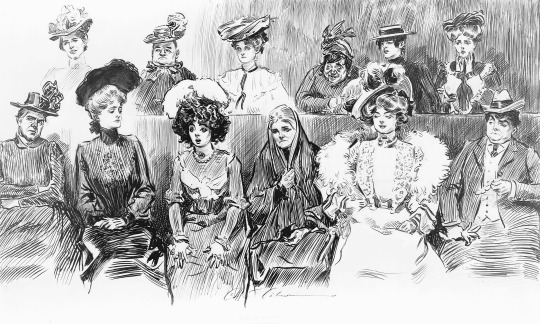
“Studies in Expression. When Women are Jurors”, drawn by Charles Dana Gibson in 1902. The idea of women sitting on juries in the United States was subject to ridicule up until the 20th century.
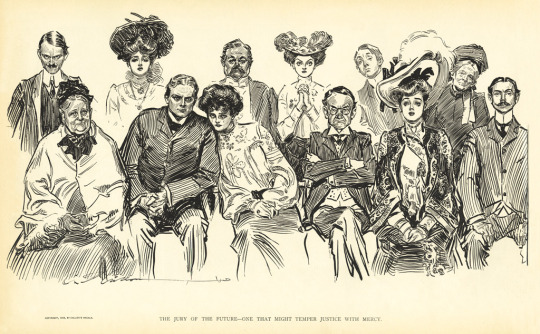
The following year the same artist followed up with "The Jury of the Future. One that Might Temper Justice with Mercy" (1903). It was thought that women were more compassionate than men, an idea that still exists today.

H.H. Frazee had previously produced Edward Peple’s hit play A Pair of Sixes, which scored 277 performances on Broadway in 1914. Peple’s next play on Broadway, Friend Martha in 1917, was a flop, closing after 15 performances.
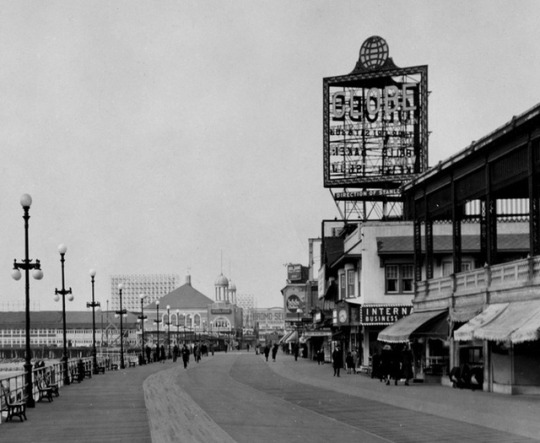
Ladies’ Day premiered in Atlantic City at the Globe Theatre on the Boardwalk on April 26, 1920. It shared the front end of a split week with All Souls Eve, a supernatural play by Anne Crawford Flexner.

Like so much about the play, it is unclear whether the above listing as Ladies’ Night was a title variation, an error by the Globe Theatre, or a typesetting error at the newspaper. The official title, however, was Ladies Day, not Night. It is ironic considering a play by that title went on to great success on Broadway - something not in the cards for Peple’s play.

Sadly for Miss Bristow, the play never reached Beantown or the Big Apple.
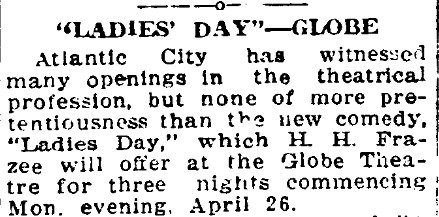
It appears that the ‘futuristic’ idea of a play with an all-female jury and lawyers was greeted with winking derision by the press.
“The play is the best example of real satiric comedy our stage has seen in a long time.” ~ ATLANTIC CITY PRESS

“While the author has not written a great play here, he makes us all grateful for a clean, bright travesty that comes as a grateful relief to the bedroom type of risqué farce that has held our stage for so long.” ~ ATLANTIC CITY PRESS

Shortly after Ladies’ Day premiered in Atlantic City, Frazee made headlines by purchasing Fenway Park in order to save it from bankruptcy. In January 1920, as owner of the Boston Red Sox, Frazee sold their prize player, Babe Ruth (above), to the New York Yankees, thus initiating the legendary ‘Curse of the Bambino’ for the Red Sox. It was well known that Frazee’s baseball dealings helped finance his theatrical endeavors, most notably the play that inspired the musical No, No, Nanette, My Lady Friends (1919). Coincidentally, both plays are partly set in Atlantic City NJ.
Even more coincidentally, the term “ladies’ day” in a baseball context was generally when women spectators were encouraged to attend ballgames, sometimes using promotions or give-aways.
Before leaving the Garden State, the play did a night in Paterson at the Lyceum on May 1st. On May 4th it played also single night at the Lyric in Allentown PA. On May 5th, the play was seen in Wilkes-Barre PA at the Grand Theatre.

This gig at the Grand appears to be where the play closed and all involved turned to other pursuits:
In June 1920, playwright Peple contributed his one-act play “The Golden Egg” to the Annual Lambs Club Gambols in New York City. On June 28th, his new comedy Maggie opened in Rochester.
In August 1920, a film version of Peple’s 1905 play The Prince Chap was released. That same month, a play opened on Broadway titled Ladies’ Night, also titled Ladies’ Night in a Turkish Bath. It was a huge hit.
In August 1922, it was announced that Frazee would produce Peple’s play The Little Visitor in Boston, a play set in Virginia just prior to the Civil War. It is unknown if this play was related to or inspired by his 1911 play The Littlest Rebel, which was later made into a successful film starring Shirley Temple.
#Ladies' Day#Edward Peple#H.H. Frazee#Babe Ruth#Baseball#1920#Atlantic City#Globe Theatre#Jury#Suffrage#Satire
91 notes
·
View notes
Photo
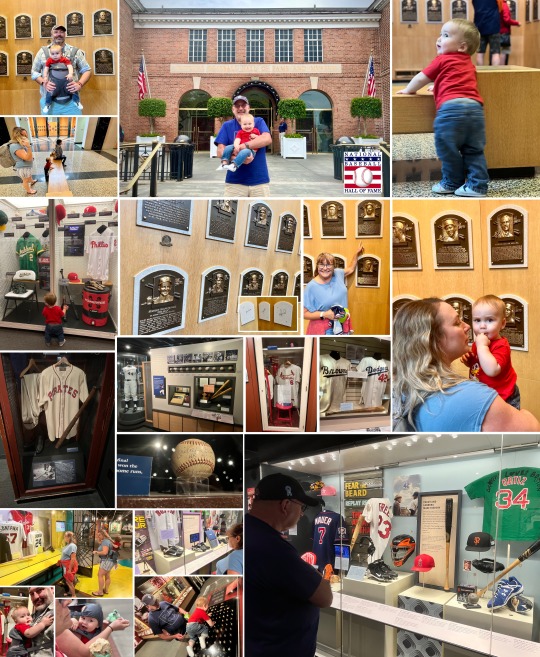
Day 172: Tuesday June 21, 2022 - “Road to Cooperstown”
Cooperstown sits down a long curvy road, through rolling hills, alongside a finger shaped lake and we wound our way there today, and it feels like winding our way back into time, as you hear the story of the first baseball game being mythologized here. Whether Doubleday started the game here or not, hardly matters. Its the perfect place for the Hall of Fame. And after walking the streets and getting ice cream, and adoring the charm of the place, I think we all would agree.
We started our afternoon visit with the Hall of Famers, and browsing the bronze plaques. David Ortiz is going into the hall this year, and in prep for next month’s induction, the empty place holders had already been hung and were signed on the marble under which the plaques will hang. Wow! I thought that was really cool and wondered how far back that tradition goes and how many hall of famers signed the back of their plaque! Neat seeing this little easter egg. Last time I was here Ken Griffey Jr., one of my favorite players as a kid, went into the hall - no doubt he had signed his too!
In the Great Hall, William practiced his walking as he cruised around, curious about this special, unique room. Baseball sanctuary, I told him, as we showed him pictures of Alan Trammel, Hank Aaron, Kirby Puckett (Mom’s favorite non-3rd baseman), and Babe Ruth. In one of his newest tricks, he said in context, “Wow” - yea buddy, wow.
On to the exhibits we all quietly took our own routes, reading whatever was interesting or eye-catching. From the first exhibit with Honus Wagner’s Pirates Jersey to the last exhibit with all the World Series rings that we let William crawl on and get a closer look, the Hall is the keeper of the game, telling a story of how its evolved and changed. My favorite parts were the same as last time, the old lockers and game worn jerseys; we saw Hank Aaron’s whole uniform, Babe Ruth’s, Stan Musial’s, and Jackie Robinson’s. We saw a Mickey Mantle signed baseball and I told AC about how I wrote to him when I was in grade school and got a signature back in the mail and how because of that, for a long time I was a Mickey Mantle and Yankees fan... for a short while. We had heard that Miggy’s jersey from his 3,000th hit this Spring had been sent to the hall, but it wasn’t on display yet - instead his Triple Crown jersey was here. I told William about how someday soon, he’d have his bust in Cooperstown but that last night we saw him swing in Fenway. I enjoyed seeing Dave Robert’s shoes that he stole 2nd with with my Mom after having shown her the video of that moment in baseball history earlier in the truck on the way here - and there they were in the (leather) flesh. There were a few new things, or things I hadn’t noticed last time - like the display of Fantasy Baseball, David Freese’s 2011 WS Jersey, the section on the Negro Leagues, and even a whole room dedicated to Baseball Cards.
We visited the gift shop so that we could get a pin for Wm’s hat, and several packs of Cards to add to his budding collection. We then ventured out into town where I found a bat shop that does engraving and got a special bat to surprise everyone that commemorated William’s first game on a Louisville Slugger mini-bat. We also visited some card shops and got a Dylan Carlson rookie card to go with William’s signed shoe. But the big prize was a visit to a candy store for four double scoop waffle cones! Sorry buddy - maybe next time we’re here you can have one too. Maybe when that guy Miggy, is in the parade!
Song: Merle Haggard - Thats The Way Baseball Go
Quote: “Major League Baseball has done as much as any one thing in this country to keep up the spirit of the people.” President Franklin Roosevelt

1 note
·
View note
Text
Sports September I: Bull Durham (1988) - Recap (Part One)
I really want to get more into baseball.
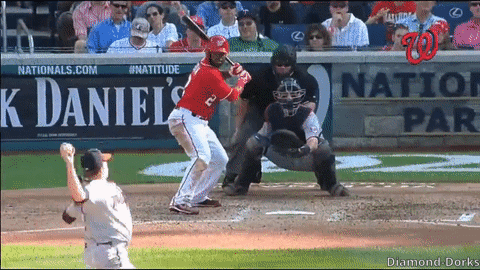
Which is a weird statement, I know. If I like it so much, why am I not already into it? Well, I’ve only just recently started showing an interest in the sport. After all, I’m an American. And there are few things more stereotypically American than the “America’s greatest pastime”.
And I’ve been surrounded by baseball my entire life. My uncle is a huge fan of the Mets; I’m living in a Red Sox state, despite being Yankee trash; I played baseball as a middle school kid, and I genuinely enjoyed it, now that I think about it; and one of my absolute favorite films as a kid (and as a nostalgic adult) is The Sandlot. I mean, of course. Ain’t nothin’ as iconically nostalgic ‘90s as The Sandlot. And yet, as a kid, I knew about as much as the sport itself as Smalls did.
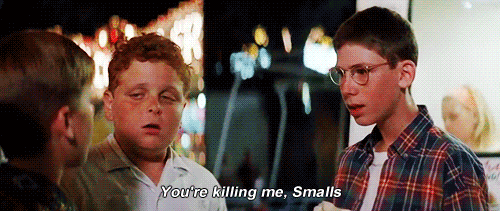
Sure, I know a bit from playing and watching movies like The Sandlot, The Kid, and Angels in the Outfield (almost forgot about that one, holy shit). Nine innings, three strikes and you’re out, bunting the ball, catcher, pitcher, innuendo (in-your-endo), outfield, infield, home run, three bases, me getting hit in ear when I was up to bat that one time because a kid from my old school was going up against us and kept distracting me while I was up to bat, but I got a goddamn walk from it, so IN YOUR FACE BERNHARDT (not his real name)
So what turned me around on the sport? Why do I now want to learn more about one’s of this country’s oldest and greatest traditions? And the answer is easy:
BASEBALL HISTORY IS CRAZY AS FUCK
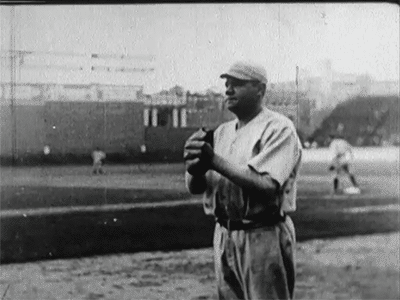
Now, there’s a LOT of baseball history. Hell, documentarian Ken Burns made a critically-acclaimed and long-ass PBS series about it (that I have yet to watch, but REALLY WANT TO). So, there being some weird-ass shit in the history of the sport isn’t exactly a surprise. But, like...baseball concentrates it somehow. Don’t believe me? Here are some of baseball’s greatest hits PUN ENTHUSIASTICALLY INTENDED:
The high-five was invented (INVENTED) by Dusty Baker and Glenn Burke of the Oakland A’s in 1977, after celebrating Baker’s 30th home run on the field. Burke was a gay African American man, the first openly gay baseball player in MBA history. And as a result, the high five gained its initial prominence as a way for the LGBT community to greet each other. YEAH! How’s THAT for a fun fuckin’ fact?!? I love it
17-year old pitcher Jackie Mitchell was the first female pitcher in professional baseball history, and was so fucking good, she struck out both Lou Gherig AND Babe fuckin’ Ruth!
Jackie Robinson was NOT the first Black American major league baseball player. Nor was Moses Fleetwood “Fleet” Walker, often called the actual first Black baseball player. No, that would actually be William Edward White, who played for the Providence Grays as a substitute pitcher in 1879. He was also the only baseball player to have been a slave. YEAH.
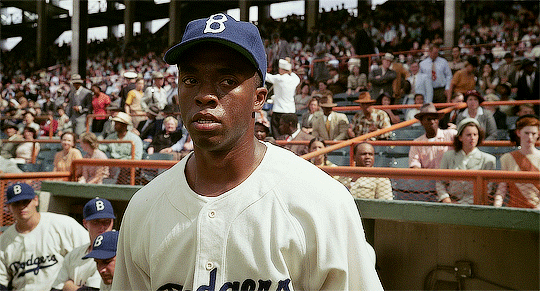
Enough history, time for the crazy shit. Bill Veeck was a baseball team owner who LOVED sensationalism. He would give away live animals to random audience members, ranging from chickens, to lobsters, to FUCKING HORSES. He gave anyone named “John” a free ticket for a game. He hired the first little person as a pitcher...although that’s a little on the shittier side, given the context, but I digress. He was HATED by other owners, and this culminated in the absolute clusterfuck that was 1979′s Disco Demolition Night. It began with a promotion for free tickets if you brought a disco record to be destroyed. It ended with a riot, the visiting team fleeing in fear, and a crowd that contained 30,000 more people than Veeck expected, most of whom were fucking SMASHED. It’s a fucking glorious moment in baseball history, and I’m BARELY covering the chaos here. Check it out, it’s fucking NUTS.
You want some chaos? I WILL GIVE YOU CHAOS. In 1974, the Cleveland Indians held a promotion known as Ten Cent Beer Night. You now know part of the problem. The other problem was that there was a limit imposed on how many beers could be bought in a single purchase...but not how many purchases one could make. The result? Streakers, mooning, a middle-aged woman walked onto the field and flashed the pitcher like a confident queen, and EVERYBODY rushing onto the goddamn stage, causing the players to beat them off WITH BASEBALL BATS. Jesus Christ, how could this get crazier?
Yankees Pitchers Fritz Peterson and Mike Kekich...switched wives and kids. I’m not even gonna elaborate on that, THEY SWITCHED FUCKIN’ FAMILIES. It...it gets crazier, but I have somebody else to talk about...
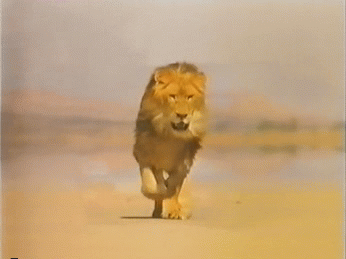
The best for last. There was a man, a beautiful majestic man, named George Edward “Rube” Waddell. My man “The Rube” was one of the greatest pitchers in baseball history, TO THIS DAY. He was also A WALKING TORNADO OF WHAT THE FUCK.
Rube Waddell chased fire engines. Yeah. If he was on the mound and a fire truck drove by, he left the mound (IN THE MIDDLE OF THE GAME) and chased that fucker down. He wore red clothes beneath his uniform just in case, despite never being a firefighter.
Fans of rival teams caught onto this, and were able to draw Rube off the mound with puppies and shiny objects. AND IT WORKED. AND I AM NOT FUCKING JOKING. This behavior almost ended his career. Well, that and...
He would sometimes disappear, only to be found bartending at a bar nearby the stadium. He did not work at these bars; he just spontaneously tended at them. He would run into the stadium, then change into his uniform while going through the stands! I’m gonna credit him with inventing streaking.
He wrestled alligators as a job in his off-seasons.
At some point during the off-season, he was bitten by a lion, A FUCKING LION, and NOBODY KNOWS HOW OR WHY. WHAT IN THE EVERLOVING FUCK I LOVE THIS MAN
And, again during the off-seasons, Rube once saved 13 people from drowning IN A SINGLE YEAR. This dude was ridiculous, and somehow also a hero. And this heroism would eventually lead to his death from pneumonia in 1913, exacerbated by the previous year of saving people during a catastrophic flood.
NOW DO YOU UNDERSTAND?
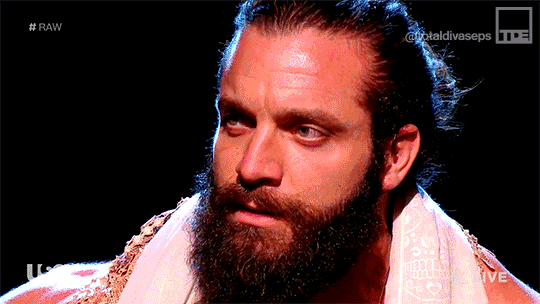
...Oh, right, Bull Durham.
This movie, directed by Ron Shelton and starring walking, mumbling piece of cardboard Kevin Costner, is considered one of the greatest sports films of all-time. It’s also potentially based on a true story, which just fuels my interests more. I just watched The Battered Bastards of Baseball on Netflix last night, so I’m super into historical baseball films at the moment!
With that, let’s go! SPOILERS AHEAD!!!
Recap: Part One
youtube
We’re treated to a Ken Burns’ style introduction, as we’re brought into the fold by baseball fan and groupie Annie Savoy (Susan Sarandon), who loves baseball SO MUCH that she makes an effort to fuck every baseball player she can, provided that they’re actually good. Yeah, there’s a whole diatribe about this, and her worship at the all-hallowed Church of Baseball. And honestly...I’m already sold. It’s very effective, and I’m ready for some worship.
At this Church, in this case being the Durham Bulls Athletic Park, in North Carolina, we’re treated to the dancing and clowning of fuckin’ Max Patkin, the Clown Prince of Baseball, and a real actual baseball clown, performing for audiences since the 1940s. Yeah, didn’t know baseball clown was fuckin’ thing, didja? God, I love this shit. Patkin even worked for Bill Veeck, AS THE COACH FOR THE CLEVELAND INDIANS! Also, that team really needs to change their name, but anyway. Genuine piece of baseball history here! Fantastic!
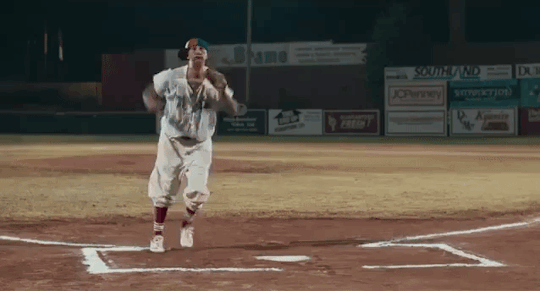
Making his debut in the stadium that night is Ebby Laloosh (Tim Robbins), a rookie pitcher with a fantastic fastball, and a lackadaisical nature. He’s late for the game, as he’s having a bit of a romp with Millie (Jenny Roberston), daughter of the owner of the stadium. She’s friends with Annie, and she helps to measure the speed of balls thrown by the pitchers.
The game against the Peninsula White Sox commences, and Ebby...Ebby is an absolutely shitty pitcher, holy shit. His speed is extremely high, but his accuracy is non-goddamn-existent! He throws the ball into the stands, the announcer’s booth, the mascot’s fleshy body, a batter’s ass...it’s not a great experience, or demonstration of his skill. Annie and Millie watch this, with Annie passing notes to the coach of the team, Joe “Skip” Riggins (Trey Wilson).
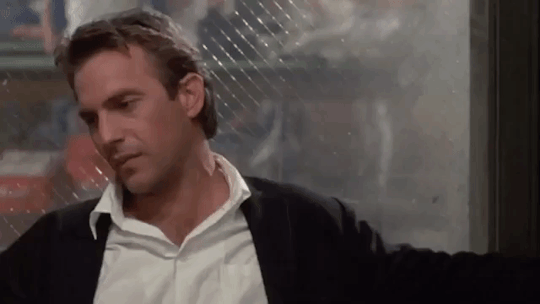
At the end of the game, Skip and assistant coach Larry Hockett (Robert Wuhl) summarize the game, and Laloosh’s unrealized potential, saying he has a “million-dollar arm with a five cent head”. At this point, they’re greeted by disaffected twelve-year veteran Lawrence “Crash” Davis (Kevin Costner), whom they’ve brought there to try and reign Laloosh in, while teaching him some semblance of accuracy. However, David is REALLY disaffected, and refuses at first...until immediately agreeing to come in as catcher.
That night at the bar, Max Patkin is talking to Annie, and introduces her to Crash Davis. Now that Annie has begun her pathway towards Inevitable Love Interest (because that’s obvious), she also gets introduced to Laloosh. They briefly scuffle over dancing rights with her, until Annie just ends up dancing with Max instead, as it should be.
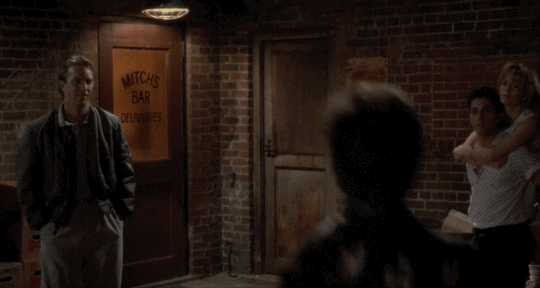
Even then, Laloosh prompts a fight with David outside, like a proper dick. But Davis dares him to hit him not with his fists, but with a ball. He guesses that Laloosh is going to miss, even at that range, and he guesses correctly. An enraged Laloosh goes up to hit him, only to get fucking LEVELED by Davis immediately, and he FINALLY introduces himself as the teach catcher. Not bad, Crash.
Although, I have to say one thing...Kevin Costner is still Kevin Costner. He’s...not not the most emotional actor, y’know? He’s actually the exact opposite, and remains one of the driest actors I’ve ever seen. How he’s been successful this whole time, I have no idea. And, like, Max Patkin’s not exactly a great actor, but he’s at lest more convincingly emotional than Costner is at any point. I...I might not be Kevin Costner’s biggest fan. I mean, he’s not bad in The Untouchables, and I guess he’s fine in Dances with Wolves, but...have you SEEN Waterworld? Jesus.

Anyway, after learning lesson number one (”Don’t think.”), they head back inside. Annie invites them both to her place, setting up what is definitely not going to be the source of future conflict. By the way, this is a good time to mention that Annie has this thing she does. See, she selects one specific player to be with throughout the course of a baseball season. And by all indications, her selection progress is, uh...thorough.
As she details this to the pair, and the fact that they’re the two prospects for the season she’s chosen, Crash shows doubts. He leaves, but not before challenging Annie’s beliefs with his own beliefs about matters of the heart.
I believe in the soul, the cock, the pussy, the small of a woman’s back, the hangin’ curveball, high fiber, good scotch, that the novels of Susan Sontag are self-indulgent overrated crap. I believe Lee Harvey Oswald acted alone. I believe there ought to be a Constitutional amendment outlawing Astroturf and the designated hitter. I believe in the sweet spot, softcore pornography, opening your presents Christmas morning rather than Christmas Eve, and I believe in long, slow, deep, soft, wet kisses that last three days. Goodnight.

...Huh. That’s a hell of a speech. Annie agrees, and asks him out on a date formally. He refuses, which intrigues her further, and bids tonight to her and Laloosh, whom he calls “Meat”. As he goes to walk through the town, Annie ties Laloosh to the bed under the pretense of having sex, then just reads Walt Whitman to him. which is, for the record, goddamn hilarious.
The next morning we meet a few more of the ball club members, including the devout Jimmy (William O’Leary) and the Santeria practicing Jose (Rick Marzan). Laloosh comes in to the locker room and reveals both that they didn’t have any sex that night, and that he has a new nickname given to him by Annie: Nuke. Nice name, honestly. Soon after, we get to see the team in action. At bat, Crash has some difficulties at the bat, which we also hear him his inner monologue. Makes sense that he understands Laloosh’s problems, given his own internal monologue. However, he ends up getting struck out, and this is noticed by Annie, who tells him what he’s doing wrong with his swing. He replies with a note of his own, and the two meet at the batting cage the next day.
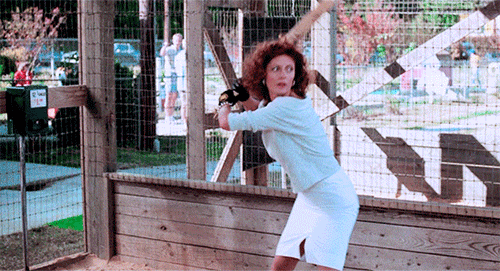
At the batting cages, Annie seems to have chosen Nuke for the season, with Crash having had his chance. Crash is a little frustrated by this, and tells her off a bit, but the two become friends. This is directly followed by Nuke and Annie having sex, only for her to accidentally call him “Crash”. Yeah, ILE status incoming.
The season progresses, and we get to know more of the team, as well as see some stunts on the field, like dropping money from a helicopter that a bunch of little leaguers are sent to grab. Some real Bill Veeck style shit, which I can dig. All the while, Crash tries to help Nuke out (and tells the opposing batters what pitches he’s throwing specifically to teach him a lesson), but the arrogant Nuke doesn’t listen at first. But eventually, he starts realizing that Nuke actually knows what he’s doing. And he starts improving...slowly.
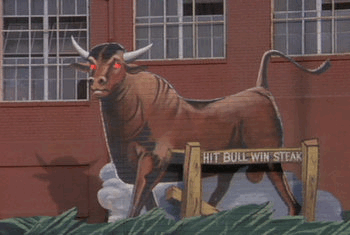
The Bulls head out on tour, during which Crash reveals his 21-day stint in “the Show”, AKA the Major Leagues. As always, the arrogant Nuke tells him off, taking taking umbrage both at Crash’s advice, and his repetition of the nickname “Meat”, the origin of which is still unrevealed. They get into a fight on the tour bus, which is quickly broken up.
Crash’s comment about Nuke wasting his Major League potential is true, though, as his pitches keep getting hit, and the team keeps up a losing streak as a result. Dude really needs to get his shit together and listen to Crash and Annie. As a result, the team’s morale is low, and Nuke’s morale is especially down. One night, Crash takes a group of the players to the stadium, with a plot to get a rainout for the game the following night. He does this by breaking into the stadium and setting off the sprinklers a bit to early, flooding the field.
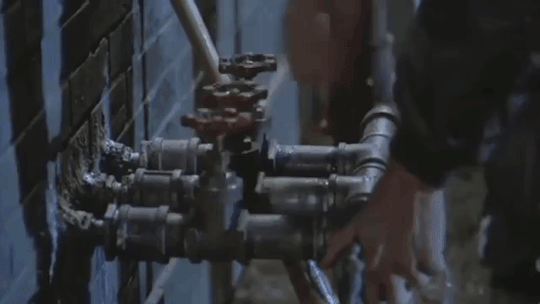
That night, Nuke has a dream of the entire stadium laughing at him on the mound, as he’s only wearing a jockstrap and Annie’s garter belt, which she gave him to wear for good luck (and to take his ever-present mind off his pitches). This is on the way back home after their less-than-successful foray out of Durham. In a reunion with Annie, he reveals his frustrations, and she tries to give him advice of her own. And for once, he actually takes it, as well as Crash’s advice. He even wears the garter belt, but goes through a bit of straight guy panic.
But even that has the desired effect, as Nuke actually has a good game! In his own head, he’s even calling himself “Meat”, despite not knowing the origin of the name. As does Crash, although he’s been doing well the entire season, unsurprisingly. Even still, he cant resist sabotaging one of his pitches one more time. But with that, the winning streak begins.
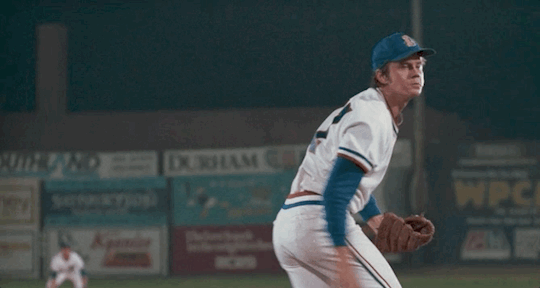
Great place to pause! See you in Part Two!
#bull durham#film:bull durham#ron shelton#kevin costner#susan sarandon#tim robbins#trey wilson#robert wuhl#user365#365 days 365 movies#365days365movies#365 movie challenge#sports september#sportstember#sports film#sports genre#sports movie#userstream#filmedit#mygifs#my gifs
10 notes
·
View notes
Text
Dorktown: The secret to not allowing homers to Babe Ruth was being bad, apparently

Bettmann Archive
The story of the two pitchers Babe Ruth faced a ton without ever homering
Babe Ruth began his Major League career with the Boston Red Sox in 1914. By the next year had become one of the very best pitchers in the big leagues. But a problem quickly arose. He’d also developed into one hell of a hitter.
For a few seasons he remained solely a pitcher who dabbled in a little pinch-hitting. Then manager Ed Barrow got the bold idea in 1918 to get his bat in the lineup more often by also playing him at first base and in the outfield.
The following year, even while pulling double-duty, he hit 29 homers, breaking the single-season record. Then he was sold to the New York Yankees for 100 grand, whereupon they immediately closed the curtain on the whole pitching thing and just told him to play outfield and mash baseballs every day. And mash he did. Starting with year one:

Across Ruth’s 15 years in pinstripes, he faced 342 pitchers for a total of 9,200 plate appearances, resulting in 659 homers (in the process just squeaking past Roger Connor’s at-the-time-career-home-run-record of 138):
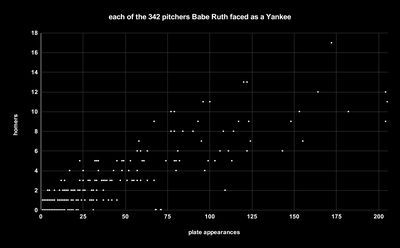
But take a close look there. Notice anything weird? Specifically, look at the row of dots representing pitchers who Ruth took deep zero times in his Yankee career. More specifically, the two dots in that row chilling in solitary (dual?) confinement. Not one, but two pitchers who he faced approximately 70 times each without ever homering.
One of them was a gentleman by the name of Ed Wells (71 plate appearances), the other was Roy Mahaffey (68 plate appearances). So they both held Ruth homerless despite the fact that he hit at least five homers against 38 of the other 41 pitchers who he faced at least that much (and even the remaining three allowed four, four, and two homers to the Babe).
Overall, Ruth homered in about 7.2 percent of his Yankee plate appearances. Here’s how it breaks down in terms of percentage against each pitcher he had a decent sample against:

With only one exception, every other pitcher allowed homers to Ruth on over four percent of their encounters. Most of them by a lot.
Now, to provide some context about what it means for a supernatural slugger to have his two home run kryptonites stem from such big samples. To me, I’d say that the 10 greatest home run-hitters of all-time are the nine members of the 600-home run club, plus Mark McGwire. Well:
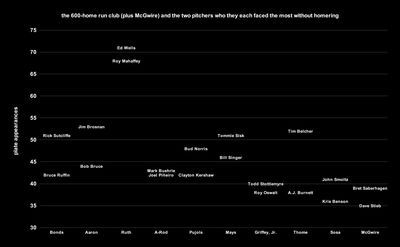
For Ruth to have faced one pitcher so much without homering is really bizarre. But two? That’s like bizarre squared. Now granted, Ruth’s Yankee tenure was during an era in which his league was much smaller than it is today. He played just seven teams over and over for a decade and a half. Additionally, relief pitchers weren’t used anywhere near as extensively back then as they are in modern times. So that all meant there were plenty of pitchers Ruth faced a lot of times, but also that he faced a mere 362 overall in 15 years as a Yank.
As opposed to more recent history when it’s not at all unusual for players with lengthy careers to wind up facing well over 1,000 different pitchers. But that necessarily stretches thin the average amount of matchups that player has against each pitcher.
For example, Jim Thome had nearly as many career plate appearances as Babe Ruth, but there was only one pitcher (Brad Radke) that he faced more than 70 times, and none that he faced as many as 80 times (for perspective, in Ruth’s Yankee career there were 24 pitchers who he faced at least 100 times, three up over 200). So that obviously makes it pretty hard to have guys you face that much without ever homering when there are barely any guys you’re facing that much to begin with.
Nevertheless, we’re still talking about Babe Ruth here. Regardless of how large the pool of pitchers he regularly competed against was, it’s still an upset of epic proportions that there could’ve been even one who he didn’t hit a single homer off of. Let alone two. To ostensibly have a 7.2 percent chance of doing something, yet not doing so in any of 68 (1-in-156 chance) or 71 (1-in-195 chance) opportunities is pretty unlikely individually, let alone collectively.
And indeed, Mahaffey and Wells’ placement on all those scatter charts relative to all the other data points is quite impressive. But what really kicks the absurdity into even another gear is that whereas the chances of a Babe Ruth homer in a random plate appearance was about 7.2 percent, against Mahaffey and Wells specifically, you’d think it would’ve been much, much higher — not lower.
Because while one might naturally figure Roy Mahaffey and Ed Wells were both superstar, transcendent pitchers, they were not. No, actually, they were not even good pitchers. No, actually, they were bad. No, actually, they were each the very worst (decent-volume) pitchers in all of baseball throughout the entirety of the periods in which their Ruth encounters occurred.
For Mahaffey, that was 1930-1934:

For Wells, that was 1923-1934 (four of those years as Babe’s teammate notwithstanding):

In case you’re wondering if Ruth’s lack of homers against them was potentially a product of simply walking a ton, the answer is no. For two main reasons. One, Mahaffey and Wells combined to walk him 29 out of 139 times. That is about 20.9 percent — right in line with the 20.1 percent of all plate appearances in which Ruth walked during his time with the Yankees. And two, walks also pad the plate appearance totals that Ruth had against all the other pitchers, too; they’re reflected with everyone, not just Mahaffey and Wells.
It was already bewildering that there was one, let alone two, pitchers that could face Ruth that much without allowing a single homer. Then the idea that even one of the two pitchers could have been anything other than one of the very best in the game seems unfathomable. Let alone not even average. Let alone arguably the worst in the Majors during the relevant time period. And both of them were!
In the name of completeness, let’s remove the Yankee restriction — since he did have 1,424 plate appearances (and 55 home runs) with the Red Sox and Braves — to provide a total and comprehensive snapshot of every plate appearance of Ruth’s career (he had over 1,600 career plate appearances that stem from games of which play-by-play data does not exist; it required the development and execution of a plan to ascertain which pitcher each of those plate appearances was against — if you’re curious to see the overall raw numbers, or just the product of some good ol’ masochism, here you go):

You may notice a dot in that one representing another pitcher who Ruth faced nearly as much as Mahaffey and Wells without ever hitting a homer. That would be Black Sox scandal legend Eddie Cicotte. But there are two gigantic asterisks that make the story with Cicotte completely different.
One is that the overwhelming majority of their showdowns came when Ruth was still a Red Sock; in other words, before Babe Ruth truly became BABE RUTH. Wells was squaring off against Ruth during most of Ruth’s prime and, though he came along a bit later, Mahaffey still mostly faced a near-peak version.
The other is that while Mahaffey and Wells were as bad as anyone during their windows facing Ruth, Cicotte was dominant. In three of the five seasons in which Ruth faced Cicotte, Cicotte had a minuscule, sub-2.00 ERA. Still kinda surprising, but easily explainable.
But never hitting a single homer in his best years off two of the lousiest pitchers in the game in a combined 139 tries? Well, that’s just baseball for you.
0 notes
Text
Shohei Othani, Babe Ruth, Hot Starts and Changing Projections


Babe Ruth the hitter will probably never make sense to me. He really shouldn’t make sense to anybody. If you’re reading this, you’re probably at least a little bit aware of his slugging statistics that all look like typos or hilarious lies we all tell ourselves to pat ourselves on the back for inventing baseball. In 1920, Ruth hit 54 home runs. Which is four more than any other American League team hit for the full season. And so forth and so on. In order for anyone to touch his single-season hitting records, you’d probably need a scenario where 80 years later, we all agreed that it was okay for the guy who was already the best player in baseball to get pumped full of the most advanced human growth hormones we had. And even in that scenario, Babe Ruth in the Twenties still makes absolutely no sense.
But what about Babe Ruth the pitcher?
We’re gonna hear a lot about that guy this year. Especially if Shohei Othani keeps hitting three home runs in a week and then goes out on the mound and flirts with a perfect game in his next outing. Comparing anybody who isn’t Barry Bonds-on-clydsdale-semen to Babe Ruth is completely and unnecessarily unfair. But in this case, there’s really nobody else to compare him to.
From 1914-1919, Babe Ruth was a starting pitcher for the Boston Red Sox. And yeah, he started getting a reputation for hitting massive home runs. And crowds were bigger on days Ruth pitched because they wanted to see him do more of that. He also had a reputation for being a bit of a maniac. In one outing in 1917, he walked the first batter he faced, got pissed enough at the umpire to throw a fucking punch at him. And then after he was ejected, Ernie Shore came in and retired 27 batters in a row. For the longest time, Shore’s performance was recorded as a perfect game. But as it stands now, it’s probably just the most bizarre combined no-hitter that’s ever happened.
But there was also a time Ruth might have been the best left handed pitcher on the planet. In 1916, he pitched head-to-head against Walter Johnson five times and won four of those games. I’m not a Wins Guy, but that’s still impressive when the other guy is inarguably one of the five greatest pitchers of all time. Ruth also pitched a 14-inning complete game in the World Series that year. And he also led the league in ERA, Complete Games and Shutouts. And if you’re just looking at his stat line of a 1.75 ERA, a 2.43 FIP and a 4.5 WAR, taken completely out of context, that’s fucking Dwight Gooden in 1985, Greg Maddux in ‘94-’95, Pedro Martinez in 2000 shit. Yeah, it was in the Deadball Era that he single-handedly ruined. But look at his career stats, compared to surefire, First Ballot Hall of Famer, and GOAT, Mariano Rivera.
Ruth. 1221.1 IP. 2.28 ERA 2.81 FIP
Rivera. 1283.2 IP. 2.21 ERA 2.76 FIP
You just have to shrug. Ruth makes no sense. Ohtani makes no sense. But I think I’m gonna keep have fun trying.
Let’s go around the League.


AL East.
With the Red Sox blasting off a 10-2 record and the Yankees sitting just below .500, the projections in the East have already changed. The Red Sox are now projected at 96-97 wins to win the Division. And the Yankees are looking at 91-93 wins and another Wild Card. I’ll start bragging about calling that two weeks ago when any of the games are above 40-degrees. But this divisional race, plus another full-on brawl makes me giddy to watch this rivalry unfold over the rest of the season. Especially when Giancarlo Stanton figures it out. Homebody is not hitting well. He had another zero-hit, five-strikeout game this week. And nobody has ever had two zero-hit, five-strikeout games in a season before, let alone by the end of April. He never even had a four-strikeout game last year. Joe DiMaggio only struck out 13 times in 1941. Yogi Berra struck out 12 times in 1950. Stanton has 23 K’s through 13 games. It’s getting so much attention that nobody seems to be noticing that...
AL MVP: Didi Gregorius, New York Yankees.
Didi has the second-highest WAR in baseball right now. He also has the highest wOBA in the American League and highest wRC+ in the Majors. He’s also tied or leading in stats you’ve heard of like RBI, SLG and OPS.
AL Central.
The Indians have the worst batting average, on-base percentage and OPS in the Majors. And they’re still tied for first place. Because, and stop me if you’ve heard this, their pitching is fucking awesome. Also, check out Joe Mauer’s stats in Minnesota. Does anybody feel like talking about that? He’s hitting .412 and leading the Majors in OBP too. Or do we have to ignore everything about this division for as long as we can? Let me know.

AL West.
Everybody still seems to think the Astros are the best team in baseball by a wide margin. But the Angels are currently in first place. So if this keeps up, we might be looking at an even better playoff race than Yankees-Red Sox. And honestly, doesn’t Mike Trout deserve to have something nice at some point in his life? He’s just given us so, so much.
AL Cy Young: Gerrit Cole, Houston Astros.
It’s almost unfair. Right now Cole is tied for 5th in the League in WAR, he’s 3rd in ERA with a 0.64 and he leads the AL in FIP. If the Astros are going to become the ‘98 Yankees, he’s going to be the reason.
AL Rookie of the Year: Shohei Ohtani, The The Angels Angels.
I’d pick him if he was just a DH. I’d pick him if he was just a pitcher. At one point in the past week, he had more strikeouts than Max Scherzer and more home runs than Aaron Judge. We should probably all buy tickets to see him play in the real near future.



NL East.
Well, are we buying the Mets yet? At 10-1, they have the best record in baseball and their projections (87-88 wins) are pulling just about even with the Nationals (88-89). And the East Coast Media has decided to anoint new manager, Mickey Callaway as the greatest person to ever great. Almost like a bizarro version of Gabe Kapler in Philadelphia. Because, oh man, people hate that guy. I’m gonna hold off on calling for a rematch to the ‘86 World Series for the time being. Like I said earlier, every game looks like it’s being played on Hoth for tauntauns and wampas. I’m also gonna hold off calling for the Miami Marlins to move to Montreal. But that’ll probably be a thing I do later on in the season.
NL MVP: Bryce Harper, Washington Nationals.
Mr. April is locked in yet again. He’s leading the League in WAR and he’s been the second-best hitter (wOBA and wRC+) to Rhys Hoskins of the Phillies. Harper also leads the NL in Runs, Home Runs and Slugging. Get paid, young Bryce.
NL Cy Young: Max Scherzer, Washington Nationals.
He leads the League in WAR, he’s second in FIP and he’s got an 0.90 ERA. Scherzer is the best pitcher in baseball. I get grouchy now when anyone tries to say it’s anyone else. Dude stole a base this week. Let’s see Corey Kluber do that. Pussy.

NL Central.
The Pirates are still projected at 80-83 wins. The Cubs are still projected at 92-93. It honestly doesn’t feel that way right now. Then again... now I wish I’d seen Frozen so I could make an amazing movie reference to how cold it is. But can you imagine Pittsburgh with Jameson Taillon AND Gerrit Cole right now? Yikes. But mostly I want to talk about that motherfucker, Yadier Molina. Man, I hate him. This week Yadi went batshit because Diamondbacks’ manager, Torey Lovullo, said, “That motherfucker is framing pitches” or something like that. And Yadi probably doesn’t like when people find out he has loveless sex with his own mother. Either that or it’s a figure of speech, Yadi. You tell me. What an idiot. You’re 35-years old and make $15 million a year. You can probably afford to take a lady out to a fancy dinner. You probably don’t need to keep boning your moms all day. You know, because he obviously does that shit. Really. I think I’m serious.
NL West.
Okay, fine. I’ll buy the Diamondbacks. Right now FiveThirtyEight only has them one game behind the Dodgers in their playoff projections. And I’ll wait another week to see if LA is still 26th in Runs, 20th in Batting Average, 25th in OBP, 24th in SLG... you get the point. Yasmani Grandal should probably not be the best player on the team if they want to win.

NL Rookie of the Year: Joey Lucchesi, San Diego Padres.
Nobody has really emerged in the NL to capture the baseball media’s attention. So I guess I’ll give Lucchesi a slight edge over Shane Carle of the Braves and Brian Anderson of the Montreal Miami Marlins. So this would be just as good of a time as any to remind you that Yadier Molina has the hots for his mom.
Okay. See you next time when the weather isn’t ice dragons and Leonardo DiCaprio dying of hypothermia next to a sunken ship. If you want, I have a podcast with Joe Kilgallon that you can find on all the iTunes things. Til next time, don’t look at your mother that way, Yadi.
0 notes
Text
Shohei Ohtani’s Value Has No Precedent
The derby for Japanese baseball superstar Shohei Ohtani has nearly reached its long-awaited conclusion, after the pitching-and-hitting phenom narrowed his list of preferred teams down to seven. (Notably, the list doesn’t include either the New York Yankees or Boston Red Sox — Ohtani is reportedly leaning toward smaller-market and/or West Coast clubs.) If MLB’s best two-way player since Babe Ruth1 is on his way, we’ll know soon which uniform he’ll wear while revolutionizing the game.
On the field, scouts are sold on Ohtani’s potential (if not his durability) as a top pitcher, as well as his speed and raw power as a hitter. And the statistical projections think he’ll be very good no matter what position he plays. According to the ZiPS system, developed by ESPN’s Dan Szymborski, both Ohtani’s ERA and his on-base-plus-slugging projections figure to be about 20 percent better than league average2 over his next five seasons in the big leagues. For context’s sake, only 58 hitters and 79 pitchers met either of those qualifications over the preceding five seasons. Ohtani has the potential to hit both benchmarks.
Of course, there’s also a lot of uncertainty around Ohtani’s projection to the American game, as is always the case with players whose backgrounds are in the different flavor of baseball being played in Japan. To get a sense for which other players from Japan had numbers similar to Ohtani’s, I looked at Clay Davenport’s translated Japanese-league statistics for native-born players with at least 700 MLB plate appearances or 200 innings pitched. (Specifically, I used the peak-adjusted version of Davenport’s stats, which accounts for a player’s age and tries to peg how good he’ll be in his prime.)3 I then ran Bill James’s Similarity Scores for each set of statistics — after converting them all to a per-season format — to give us the pitchers and hitters whose body of work most resembled Ohtani’s before arriving in America.
Who will Shohei Ohtani pitch like?
Translated, peak-adjusted per-season Central and Pacific League statistics for Japanese-born pitchers with at least 200 MLB innings pitched
MLB CAREER TRANSLATED JAPANESE STATS NAME ERA WAR W L SV IP ERA SO/9 BB/9 HR/9 SIMILARITY Shohei Ohtani — — 18 9 0 218 3.34 8.1 3.0 0.6 1000 Yu Darvish 3.42 19.2 17 11 0 250 3.72 6.7 2.9 0.6 949 Masahiro Tanaka 3.56 12.7 17 11 1 256 3.72 6.3 2.2 0.7 948 Akinori Otsuka 2.44 6.0 6 3 27 79 3.07 9.7 2.9 0.8 928 D. Matsuzaka 4.45 9.0 16 12 0 243 3.91 7.1 2.9 0.8 919 Koji Uehara 2.66 13.1 13 11 3 217 4.06 5.9 1.6 1.2 893 Kazuhiro Sasaki 3.14 3.9 6 5 35 96 3.87 9.3 3.5 1.2 884 Hideo Nomo 4.24 23.9 16 14 0 264 4.31 8.4 4.6 0.9 872 H. Iwakuma 3.42 14.2 13 13 0 232 4.34 5.0 2.4 0.8 865 K. Kawakami 4.32 1.8 13 12 0 222 4.41 5.4 2.4 1.0 859 Hideki Irabu 5.15 3.4 11 11 2 202 4.33 7.3 3.9 0.8 859 Kenta Maeda 3.80 4.1 13 12 0 225 4.41 5.1 2.5 0.8 856 Masato Yoshii 4.62 6.2 9 9 11 165 4.52 4.6 2.8 0.9 841 Takashi Saito 2.34 9.5 10 11 6 189 4.69 5.9 2.8 1.2 827 Hiroki Kuroda 3.45 22.1 12 13 0 222 4.83 4.8 2.8 1.1 821 Kazuhisa Ishii 4.44 0.8 10 11 0 194 4.81 7.7 4.5 1.1 809 H. Takahashi 3.99 1.3 10 11 2 196 4.87 5.3 3.2 1.2 807 S. Hasegawa 3.70 7.9 11 14 0 225 5.25 3.9 2.9 1.1 789 Hideki Okajima 3.09 4.7 5 5 4 91 4.81 7.2 4.4 1.1 780 Tomo Ohka 4.26 11.0 4 7 0 109 5.76 4.3 5.6 0.9 773
Peak-adjusted statistics take into account a player’s age and project his numbers to a player’s prime seasons. The per-season adjustment converts all numbers to 68 games + starts.
Sources: ClayDavenport.com, Baseball-Reference.com
Ohtani’s pitching numbers bore a strong resemblance to those of Yu Darvish and Masahiro Tanaka, two of the most highly touted — and successful — Japanese imports of the past decade. Of course, they might also represent the best case scenarios for how Ohtani’s career will play out on the mound; for example, Daisuke Matsuzaka’s track record was only slightly more dissimilar, and he ended up being pretty average over his time in MLB. And the matter of Ohtani’s durability can’t be dismissed — these numbers are projected to a full season of work, but Ohtani never pitched more than 160⅔ innings in a season in Japan, and he was limited to 25⅓ innings in 2017 because of various injuries. However, my old colleague Ben Lindbergh has shown that Japanese pitchers tend to age better (and hold onto more of their value) than comparable MLB pitchers, reputation be damned. And in general, the pitchers on the list above that graded as more similar to Ohtani ended up having the better major-league careers. Statistically speaking, there’s little to quibble with in Ohtani’s pitching résumé.
Who will Shohei Ohtani hit like?
Translated, peak-adjusted per-season Central and Pacific League statistics for Japanese-born hitters with at least 700 MLB plate appearances
MLB CAREER TRANSLATED JAPANESE STATS NAME OPS WAR AVG 2B 3B HR BB SO SB OPS SIMILARITY Shohei Ohtani — — .295 42 4 23 56 132 6 .878 1000 Hideki Matsui .822 17.1 .287 32 4 20 65 106 5 .843 967 Kosuke Fukudome .754 4.3 .285 34 10 11 76 118 10 .830 947 Ichiro Suzuki .759 58.9 .332 27 7 10 51 50 27 .856 921 Norichika Aoki .738 9.9 .297 21 7 5 61 66 21 .765 917 So Taguchi .717 2.6 .257 25 5 4 38 89 10 .650 858 Tsuyoshi Shinjo .668 3.3 .237 24 7 11 37 113 9 .651 850 Kazuo Matsui .701 5.4 .288 26 10 8 40 91 33 .754 843 Akinori Iwamura .720 4.8 .273 24 8 12 59 126 10 .764 831 M. Kawasaki .609 1.7 .274 16 11 2 41 71 29 .676 788 Tadahito Iguchi .739 6.5 .251 22 6 12 47 122 25 .688 788 Kenji Johjima .721 6.1 .280 29 3 14 39 66 8 .750 736
Peak-adjusted statistics take into account a player’s age and project his numbers to a player’s prime seasons. The per-season adjustment converts all numbers to 600 plate appearances.
Sources: ClayDavenport.com, Baseball-Reference.com
As for Ohtani’s batting stats, only two hitters — fellow outfielders Hideki Matsui and Kosuke Fukudome — stand out as being highly similar to their younger counterpart, and they also represent two potentially divergent paths for Ohtani’s performance at the plate. After a 10-year MLB career spent mostly with the Yankees, Matsui ended up being the greatest Japanese power hitter ever to play in the U.S. (and the second-best position player, behind future Hall of Famer Ichiro Suzuki). Ohtani’s power stats in Japan were every bit as impressive as Matsui’s were before he arrived stateside; in terms of translated stats, the former has the latter beat on home runs and doubles per 600 plate appearances, in addition to slugging percentage and OPS. But it’s important to note that Fukudome’s numbers weren’t too far behind, and his MLB career is largely viewed as a disappointment.
It’s also worth pointing out that few hitters who profile as powerfully as Ohtani have even tried to make the leap from Japan to the major leagues. Japanese position players have more frequently been cast from a similar mold as Ichiro, whose game was based around speed and hitting for average, not blasting monster home runs. (At least, not outside of batting practice.) So on the batting side, Ohtani will be exploring territory still somewhat uncharted by past Japanese prospects — a matter made even more complicated by scouts’ assessments that his swing needs shortening and concerns that he won’t be able to make the proper adjustments unless he gets a lot of reps against MLB-caliber pitching.
But even if he ends up being more like a mashup of Matsuzaka and Fukudome than Darvish and Matsui, Ohtani would still have plenty of value because of the unique dual role he could fill. A league-average pitcher in 150 innings plus an average hitter with 100 plate appearances would be worth 1.8 wins above replacement (1.5 with his arm and 0.3 with his bat).4 Those stats alone would fetch nearly $20 million on the free agent market — and that’s without even considering the ways in which Ohtani might “break” the very framework of WAR itself.
Systems like WAR are designed to judge the value of pitchers’ batting relative to other pitchers, so the total offensive WAR for pitchers in a given season adds up to about zero. (Because pitchers tend to be horrible hitters, this essentially means the per-inning position adjustment for pitchers is astronomical compared even with that of catchers, the nonpitching position that gets the biggest positional boost.) If he spends a decent chunk of time in the field and/or proves to be a solid hitter, Ohtani could force the curators of WAR at Baseball-Reference.com and FanGraphs to do some mathematical gymnastics, weighting his position adjustment and offensive production for the plate appearances he gets at pitcher and in the field. Or maybe they’ll just calculate two separate versions of batting WAR for Ohtani — one that treats him like a pitcher and another that considers him a position player. Either way, WAR wasn’t designed with a player like Ohtani in mind.
There’s also the added benefit of Ohtani’s bat off the bench as a pinch-hitter or a designated hitter on days he isn’t starting, which would give his team extra roster flexibility. This was previously discussed when considering the ways in which FiveThirtyEight favorite Ben Zobrist frees up roster space by playing a bunch of different positions; when studying the matter, Baseball Prospectus’s Russell Carleton found that Zobrist’s versatility probably earned his then-team, the Tampa Bay Rays, a couple of extra runs per year. The value of converting a pitcher’s roster spot into a functional hitter/position-player on some of his off-days is probably even greater, and it might play into the decision of which league Ohtani ultimately ends up joining.
In the American League, Ohtani would presumably play DH to save the wear and tear on his body in between starts, though the intrinsic value of a DH is the lowest of any position (therefore raising the bar for his hitting production), and he wouldn’t get in any extra trips to the plate on days he was pitching. In the National League, Ohtani could hit for himself during starts, make better use of his above-average fielding skills on off-days and need less impressive hitting stats to produce value. (Plus, if he ever came out of the bullpen, he could even be the rare reliever who stays in the game when his lineup slot comes up.) For those reasons, it does seem like the NL would offer more opportunities for Ohtani’s unique repertoire of skills to add value.
But that’s all speculation at this point. The truth is, the MLB hasn’t seen a two-way player like this since the days of Wes Ferrell and Red Ruffing, each of whom played most of their careers before World War II. Baseball has gotten so specialized that it’s been assumed that no pitcher — not even the Carlos Zambranos, Mike Hamptons or Madison Bumgarners of the world — would ever be a viable regular hitter again. But Ohtani could prove all that wrong if his translated numbers, well, translate. No matter where he ends up signing, it’s going to be ridiculously entertaining to watch it all play out.
from News About Sports https://fivethirtyeight.com/features/shohei-ohtanis-value-has-no-precedent/
0 notes
Text
11 Of the Most Interesting Activities for Your Upcoming Corporate Team Outing
11 Of the Most Interesting Activities for Your Upcoming Corporate Team Outing
Babe Ruth, the famous Baseball player said that “The way a team plays as a whole determines its success. You may have the greatest bunch of individual stars in the world, but if they don’t play together, the club won’t be worth a dime.” What he said in the context of...
For Details please visit: http://www.healthandfitness.webbotic.org/11-of-the-most-interesting-activities-for-your-upcoming-corporate-team-outing/
0 notes
Text
Dorktown: A Hall of Fame pitcher’s most outrageous accomplishment was with his bat

This photo of Don Drysdale with Donna Reed is the only picture we could find of him holding a bat. But in the summer of 1958, out of nowhere, he became a god at the plate.
Don Drysdale was a Hall of Fame baseball player for the Dodgers and one of MLB’s all-time great pitchers. To pinpoint one chart that encapsulates his pitching mastery, let’s go with the fact that he had eight workhorse seasons (min. 200 innings) in which he posted a sub-3.00 ERA — a number surpassed by only five other pitchers since the birth of the live-ball era 100 years ago:

Throughout the early-to-mid-1960s, he and his teammate Sandy Koufax constituted two of the best pitchers on the planet, and they even dragged middling offenses to World Series-winning seasons in 1963 and 1965.
However, nothing he did on the mound is the reason he became a Dorktown hero.
While Drysdale was a pretty good batter for a pitcher, posting a career OPS above .500 when the average pitcher’s was under .400, for a period of time in 1958 he was nothing short of a Greek god while at the plate.
On August 14th, he took Cubs reliever Marcelino Solis deep in his last at-bat of the game. His next game, he went 1-for-3 while homering off Braves starter Carl Willey. Then, in his next game, also against the Braves, each of Drysdale’s first two at-bats resulted in homers off Juan Pizarro.
For those scoring at home, that’s four dingers in a six-at-bat stretch … by a pitcher. Which is about as ludicrous as it gets, right? Indeed, pitchers historically homer in right around 0.5% of their at-bats, meaning the odds that the universe would ever enable a pitcher to homer at least four times in a given six-at-bat span are roughly 1-in-107.5 million.
But let’s not stop there, because it gets even more fun when you zoom out a bit. Eight at-bats prior to that homer off Solis, he victimized Alex Kellner with a long ball in Cincinnati. Six at-bats prior to that, and again against the Braves, Drysdale had homered off Joey Jay. And last but most certainly not least, four at-bats before that, on June 26th, he homered. Guess which team it was against?
So that’s three home runs in the 18 at-bats leading up to four in six. Add it all together, and that’s an absolutely whopping seven (7) home runs across a stretch of just twenty-four (24) at-bats … by a pitcher.
Likelihood? About 1-in-39.8 billion. With a B. Hell, for a pitcher, seven home runs in an entire season is incredible. In fact, only five other pure pitchers — Wes Ferrell, Bob Lemon, Don Newcombe, Earl Wilson, and Mike Hampton (and even Lemon wasn’t a pitcher for the first chunk of his career) — have ever done so.
That season, the only position player to homer so much within a 24-at-bat stretch was some dude named Willie Mays:

To be fair, there’s a slim chance that chart’s not completely airtight. The methodology there was figuring that it would be pretty likely such a 24-at-bat stretch by a player would come within an eight-game span of his team’s season (would generally expect about six games to equate to 24 at-bats, so this gives some decent wiggle room to absorb losing some at-bats to some combination of missed game(s) with injury/day off, merely pinch-hitting, drawing a bunch of walks, etc.)
Therefore, a manual exploration on baseball-reference of every feasible eight-game stretch, starting with 1-8, then 2-9, then 3-10 …... 149-156 was necessary. It often required checking which at-bat number homers were hit within the games that both started and ended the stretch, in order to determine if it fit within the parameter of 24 at-bats.
So while it’s theoretically in the realm of possibility someone had such a stretch that was bookended more than eight team games apart, those charted are likely all (or at least close to all) the instances of any MLB player hitting even five home runs within a 24-at-bat stretch in 1958. A pitcher hit seven!
Additionally, here’s the number of home runs hit by every player in the league during that window, as a function of at-bats:

Only 21 other players joined Drysdale in hitting at least seven home runs in that time, and those 21 averaged 178.3 at-bats. A position player ever having a power surge like Drysdale did is beyond remarkable. A pitcher doing so is completely loony.
For a bit more context, in 1927, Babe Ruth hit 60 homers. No one did that again for decades. To this day only four other players (Barry Bonds, Mark McGwire, Sammy Sosa, and Roger Maris) have ever done it. It was the greatest home run-hitting season in the career of arguably the greatest home run hitter of all-time.
Babe Ruth never had a 24-at-bat stretch in which he hit seven homers in 1927.
On top of all that, as previously alluded to, somehow five of the seven Drysdale homers came against the Braves. Well damn, so the Braves’ arms must’ve been embarrassingly bad. Nope!

And the only reason they didn’t allow the fewest home runs in the league was because of, well, Drysdale. The four Braves who allowed five homers to him (Willey, Jay, Pizarro, and Lew Burdette) were all awesome in 1958. Overall, the only pitcher he took deep that wasn’t was Solis (and even he entered that game having allowed just eight earned runs across his previous 34 innings):

So it’s probably a pretty safe assumption that any of the extremely rare times in baseball history even a position player’s pulled off this feat wasn’t against pitchers as collectively strong as those victimized in this instance by a pitcher.
Forget the hours in a day and days in a week, what Drysdale pulled off is the real 24/7.
1 note
·
View note
Text
If Giancarlo Stanton wants to think 61 is the real single-season home run record, let him
He would be wrong, but at least he’s aware of how he’d be wrong.
I read this headline, and I wanted to scream.
Is Stanton the legit HR king if he hits 62? Even he wonders
Et tu, Stanton? As an unabashed Barry Bonds partisan, it’s unsettling to see this discussion begin. Because you know how it ends. It ends with every Chud & Chud In The Morning radio show agreeing that, yes, 61 home runs is the legitimate record. There will be entire episodes of Yelling My Opinion devoted to the idea. If you’re unwilling to believe that 61 home runs is the record, you’ll be firmly in the minority. The closer Stanton gets to 61 homers, the louder the bleating will get. And I wasn’t expecting Stanton to be an active part of this chorus.
Except the truth is that Stanton was pretty thoughtful on the matter.
He admitted he’s “at a crossroads” in an internal debate over what to think about all this. If PED users like Bonds, McGwire and Sosa need an asterisk by their name, he said, so does Babe Ruth since he only faced white pitchers.
And that’s the right approach. Use the context to explore the nuances. Don’t use the asterisk as a shuriken and declare that parts of baseball history don’t exist. Because I’ve been down that road before. Look, I even reached out to the internet:
And three years later, I was a good internet citizen who did the right thing.
Those were created three years ago when Bud Selig suggested that Hank Aaron was the true Home Run King. I agreed with him. Kind of. This is a similar situation.
Stanton is absolutely right that these numbers need context. Babe Ruth faced white Americans and only white Americans. Roger Maris faced expansion pitchers and played an extra eight games compared to Ruth. Mark McGwire and Barry Bonds worked out like super hard and were constantly drinking protein shakes, give or take. Unless they were both ‘roided to the gills. Either way. And Giancarlo Stanton will have played in one of the highest home run eras of all-time, with a suspect baseball that just might be different.
There are other parts to this story, though. Babe Ruth entered a league that didn’t care about home runs and left it homer-wild. He invented the very idea of a home run chase. Roger Maris had to deal with unrelenting hometown pressure that’s still hard to fathom today. McGwire and Bonds both had to face pitchers who also shopped at back alley GNCs and weren’t dragging into the dog days of summer like their predecessors were. And Stanton probably hasn’t really needed the extra two or three percent of distance that the changed balls might offer. They’re all tremendous in their own right, and if Stanton hits 62, my stars, give him all the credit he deserves. That would be an amazing accomplishment.
He would still be 12 home runs short of breaking the single-season home run record, though. I’ve run the numbers and run them again. It always checks out.
There are a couple numbers that stand out when comparing Stanton’s historic 2017 run to Bonds’ 2001 run. The first is that Barry Bonds hit 73 home runs in 2001, which is more home runs than anyone else has hit in one season. The second is that Stanton has been walked intentionally nine times this year, and Bonds was walked intentionally nine times that June. He took 142 unintentional walks from pitchers who wanted no part of him, whereas Stanton is currently at 49 unintentional walks.
Stanton is hitting these home runs in an environment where pitchers are okay challenging him because he’s occasionally willing to get himself out. They’re willing to gamble with him in a way they weren’t with Bonds. That’s not to diminish what Stanton is doing. It’s to explain the sense of reverence and wonder that I have for Bonds, and why I bristle at the suggestion that his home run record isn’t canon. Since Bonds broke that record, 25 major league hitters (and scores and scores of minor league hitters) have been suspended for performance-enhancing drugs. None of them hit 73 home runs.
Because that’s a record, you know. You probably would have heard about it.
Pretending those 73 homers were as simple as popping open a can of spinach isn’t just rude to Bonds; it’s rude to every baseball player because it suggests that all there is to hitting a baseball far is strength. I’m pretty sure Glenn Braggs could have beat Barry Bonds in an arm-wrestling match in 2001. He was ... strong.
youtube
Braggs hit 70 home runs in his seven-year career. It’s not all about the beef.
But it’s somewhat about the beef! There is absolutely no way around that. Barry Bonds had an advantage, and it helped him hit home runs. It was an advantage that all of his peers weren’t to take because of health and ethical concerns, which means that he had an unethical advantage. I promise you that the national discussion was more, “Hey, these guys seem a little big to you? Ha ha,” than “Social Norms in Baseball: How Kant’s Science of the Moral World Informs the Decision to Cheat,” but that doesn’t change the fact that Bonds had an advantage. He wasn’t just bigger, but he recovered better. His stamina was up. It was a big deal.
Which is why it’s perfectly fine to believe something like, “If Giancarlo Stanton hits 62 home runs, that will impress me more than when Barry Bonds hit 73.” That is a rational belief that can be argued, supported, disagreed with, and fought for.
What I’m not into is the unsubtle shifting of the goalposts, the snaky language and gaslighting that comes with The Real Home Run Record. Because it isn’t. Someone who hits 62 home runs will need a dozen more to break The Real Home Run Record, even if you’re already more impressed by the new accomplishment.
We’ve been here before, actually, because my colleagues and I really, really enjoy needling Pete Rose fans. It’s absolutely funny to suggest that Ichiro is the true Hit King and watch them scramble to their battle stations, and I will not apologize for this. Especially when Rose is the durf who says stuff like this:
"It sounds like in Japan,’’ Rose told USA TODAY Sports, "they’re trying to make me the Hit Queen.
But I’m not doing it just to troll. There’s an argument to be made.
Add it up, and I’m willing to entertain the argument. I’m willing to have this discussion in a loud bar as our voices escalate and escalate. Pete Rose is the all-time leader for hits in Major League Baseball history, and that’s indisputable, but what Ichiro did, spanning two decades and two countries, in an era of LOOGYs and power closers, while performing at a high level and not writing himself into the lineup, just might be more impressive.
This is the same idea. You get to choose which accomplishment impresses you the most. You get to have opinions and support your opinions.
You just don’t get to change math. I’m willing to believe that Giancarlo Stanton can break the real single-season home run record this season. He just has to hit 30 home runs over the next 43 games.
0 notes
Text
Derek Jeter’s number is getting retired, so let’s begrudgingly bow down to him and the Yankees
The idea of Jeter Week might give you hives, and I can respect that. But let me help you appreciate it for about five minutes, at least.
You do not need to explain yourself to me. You do not need to answer to the internet. You are doing what comes naturally, and you will not be judged. When you saw that Major League Baseball was running a promotion titled #JeterWeek, your eyes rolled back so far, you saw a crayon that you shoved up your nose when you were three. Derek Jeter is having a retirement ceremony on Sunday, but why limit the fun to one day, when you can have a full week, said Mephistopheles, stroking his chin whiskers?
This is sure a headline, too:
ESPN will air hours of Derek Jeter coverage in honor of his jersey-retirement ceremony
I guess technically, I watched hours of Nick Hundley coverage last night, so maybe I shouldn’t be too offended. But I’m having trouble wrapping my brain around hours of Derek Jeter coverage.
9:00 - 9:59: Birth and early years 10:00 - 10:59: Interview with high school coach (assistant) 11:00 - 11:59: Interview with high school coach (head) 12:00 - 12:10: Intermission (performance by Jeterettes) 12:11 - 12:59: The Dive (part 1) 1:00 - 1:59: The Dive (part 2) 2:00 - 2:59: The Flip (part 1) 3:00 - 3:59: The Flip (part 2) 4:00 - 4:59: The Flip (part 3) 5:00 - 5:59: Remarks from President Obama on The Flip
HOURS OF DEREK JETER COVERAGE. It boggles the mind and makes me shiver at the same time.
And yet.
I’m not saying you have to watch the HOURS OF DEREK JETER COVERAGE. I’m not saying that you need to leave your DVR plugged in, lest the hours of coverage crawl up the wires and embed themselves onto the hard drive. What I’m saying is that there’s probably a way we can appreciate this in our little corner of the non-Yankees internet.
First, focus on the Yankees. And, yes, the only reason this is a big deal is that it’s the Yankees. You do not remember where you were when the Brewers retired Robin Yount’s number. The only differences between those two players was the spotlight, era, sweet mustache, and caliber of teammates, really. Otherwise, both of them were shortstops who played 20 seasons for the same team. One of them was worth 77 wins above replacement, and one of them was worth 71. They both had a career OPS+ of 115. The both peaked around the same time, and they both suffered a decline around the same time.
Derek Jeter is Robin Yount with the backing of a major studio, in other words. He is the summer blockbuster, and it’s why people can still quote lines from Derek Jeter 20 years from now.
Yes, it’s the Yankees. That’s the point. I’ve decided you have to re2pect the hell out of the Yankees for a couple paragraphs because it is unimpeachably badass for a franchise to have every single-digit number retired. Going through the list:
1 - Billy Martin, two pennants and one championship. This is admittedly the weakest of the bunch (he managed the Yankees five times ... but for a total of eight seasons), and it seems like a way for the Yankees to remind the world they existed in the ‘80s, too.
2 - Those eyes, though.
3 - Perhaps the greatest player of all-time.
4 - One of the greatest players of all-time.
5 - One of the greatest players of all-time.
6 - One of the most successful managers of all-time.
7 - One of the greatest players of all-time.
8 - One of the greatest catchers and baseball personalities of all-time, and, oh, there’s another Hall of Fame catcher with the same number that’s retired, too.
9 - Roger Maris, another borderline one, considering he played just seven years for them. But I think everyone needs to appreciate just how revered his single-season record was before Mark McGwire came along. It’s a big reason why the McGwire-Sosa chase was so compelling.
So that’s six of the inner, inner circle Hall of Famers, bookended by a couple of nods to specific eras and accomplishments. Jeter fits right in there with them, and now that the single digits have been closed out, we can place the Yankees into a little better perspective. The Dallas Cowboys were a year old when Maris broke the home run record. The Pittsburgh Steelers were around for longer, but they didn’t do anything until the ‘70s. The Boston Celtics didn’t win their first championship until the Yankees had won 17. The Minneapolis Lakers won five championships in their first six seasons, but they came a decade after Babe Ruth retired, and they happened in a different city. The Montreal Canadiens are a professional ice hockey team based in Montreal, Quebec.
All of these teams have a rich, storied history, but the sheer number of seasons the Yankees can wave at you is extra impressive in the context of these other teams. It forces you to remember they’ve been around for so long, they’re out of single-digit numbers.
And then when you’ve begrudgingly focused on how impressive the Yankees are, now you can begrudgingly focus on how impressive Jeter is. A 20-year career for anyone, all the way down to lefty specialists, is automatically cool. The 3,465 hits are cool. The 14 All-Star Games are cool. The timing is unassailably cool, showing up after the lost decade, right when there’s some danger of losing the current decade, and helping that rich, storied franchise get back to their championship ways is absolutely gross, which is how you can also tell how special it is. It’s proportional. The more annoyed you are at a single player’s contributions to the Yankees’ success, the more impressive it actually is.
And, hell, The Dive is cool. The Flip is absolutely magnificent, even if I was rooting for the other team, and even if I don’t necessarily need to see it again. This is the portfolio of a player we would be celebrating if he were on the Padres or Brewers. Maybe without the same HOURS OF DEREK JETER COVERAGE, but somewhere in that Tony Gwynn sweet spot, where everyone can appreciate him on several different levels.
I think I was making fun of his jump throws to fit in, mostly. If we’re being honest here.
But he is on the Yankees, who like to suffocate you with the odor of their own history, and that’s where the eye-rolling comes in. My suggestion to you, then, is to separate them so it doesn’t become overwhelming. Put the Yankees over here, realize they’re going to run out of every number below 100 in the year 2531 if this pace holds, and marvel at their absurd history. Then put Jeter over here and admire him for being an institution, someone excellent at what he does for years and years and years, succeeding wildly with the help of his teammates. There are franchises in Major League Baseball right now who don’t have anyone that compares in their history.
And once you slap those two segments back together, it makes sense. This really is special. This really is cool. One of the all-time greats is getting honored by his historically impressive/oppressive team, and you’ll forgive them if they’re a little excited. You don’t need to watch the HOURS OF DEREK JETER COVERAGE, but you should probably carve out a few minutes to think about how it really was one of the best baseball careers you’ll ever watch.
Here, I’ll start: That was one of the best baseball careers I’ll ever watch.
It had the team, the timing, the right amount of drama, the memorable plays, the visibility, the consistency, the longevity, the highs, the lows. It was a career that had everything for the team that had everything. And you can still roll your eyes. But only if you sigh afterwards and say, okay, fine, that was one of the best baseball careers I’ll ever watch. It’s only fair.
After this weekend you can resume your baseball routine and let the nostalgia attack your brain and rewire what you really thought about him while it was happening. Until then, here’s one more weekend where you have to face Derek Jeter and the stupidly successful Yankees. Divide and conquer, and it won’t be that hard, I promise.
0 notes